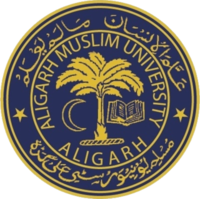Urdu: علی گڑھ مسلم یونیورسٹی | |
 Seal of the University | |
Other name | AMU |
|---|---|
Former names | Muhammadan Anglo-Oriental College (1875–1919) |
| Motto | ʻallam al-insān-a mā lam yaʻlam |
Motto in English | Taught man what he knew not (Qur'an 96:5) |
| Type | Public research university |
| Established | 1875 |
| Founders | Sir Syed Ahmed Khan |
| Accreditation | NAAC, NBA, UGC |
| Affiliation | NIRF |
Academic affiliations | ACU, AIU, AICTE, BCI, CCIM, COA, DCI, DGCA, ICAR, INC, NCTE, PCI, WES |
| Budget | ₹1,036 crore (US$120 million) (2019–20)[1] |
| Chancellor | Syedna Mufaddal Saifuddin |
| Vice-Chancellor | Naima Khatoon |
| Rector | Governor of Uttar Pradesh |
| Students | 39,367 |
| Undergraduates | 12,610[2] |
| Postgraduates | 5,756[2] |
| 252[2] | |
| Location | , , 27°54′54″N 78°04′44″E / 27.9150°N 78.0788°E |
| Campus | Urban, 1,155 acres (467 ha) |
| Colours | |
Sporting affiliations | NCC, NSS |
| Website | amu |
 | |
| Part of a series on |
| Aligarh Movement |
|---|
 |
Aligarh Muslim University is a collegiate, central, and research university located in Aligarh, Uttar Pradesh, India, which was originally established by Sir Syed Ahmad Khan as the Muhammadan Anglo-Oriental College in 1875.[3][4] Muhammadan Anglo-Oriental College became Aligarh Muslim University in 1920, following the Aligarh Muslim University Act.[3]
The university offers more than 300 courses in traditional and modern branches of education, and is an institute of national importance as declared under seventh schedule of the Constitution of India at its commencement.[5]
In the case concerning Aligarh Muslim University's (AMU) minority status, a 7-judge Supreme Court bench (by a 4:3 majority) overturned the 1967 ruling in S. Azeez Basha vs. Union of India, holding that an institution incorporated by statute cannot claim to be a minority institution.[6][7][8]
- ^ "Details of Expenditure - Classification for Budget Estimates 2019-20" (PDF). Aligarh Muslim University. Archived (PDF) from the original on 7 April 2022. Retrieved 30 March 2021.
- ^ a b c "NIRF India – Aligarh Muslim University" (PDF). 2020. Archived (PDF) from the original on 18 September 2020. Retrieved 16 January 2021.
- ^ a b Raychaudhuri, Sreerup (2021). "3. Reformers and educators". The Roots and Development of Particle Physics in India. Switzerland: Springer. pp. 19–52. ISBN 978-3-030-80305-6. Archived from the original on 17 April 2023. Retrieved 17 April 2023.
- ^ Devine, Mary Elizabeth; Summerfield, Carol (1998). "Aligarh Muslim University". International Dictionary of University Histories. Chicago: Routledge. pp. 18–20. ISBN 1884964230. Archived from the original on 9 May 2023. Retrieved 17 April 2023.
- ^ "Aligarh Muslim University offers more than 300 courses in the traditional and modern branches of education".
- ^ Bawa, Anmol Kaur (8 November 2024). "Minority Status Not Lost Merely Because Institution Was Created By Statute; AMU Minority Claim To Be Decided Based On Who Established It : Supreme Court By 4: 3". www.livelaw.in. Retrieved 9 November 2024.
- ^ Kumar, Anuj (8 November 2024). "Minority status: Aligarh Muslim University celebrates 'historic' Supreme Court verdict". The Hindu. ISSN 0971-751X. Retrieved 9 November 2024.
- ^ Kumar, Anuj (8 November 2024). "Minority status: Aligarh Muslim University celebrates 'historic' Supreme Court verdict". The Hindu. ISSN 0971-751X. Retrieved 9 November 2024.